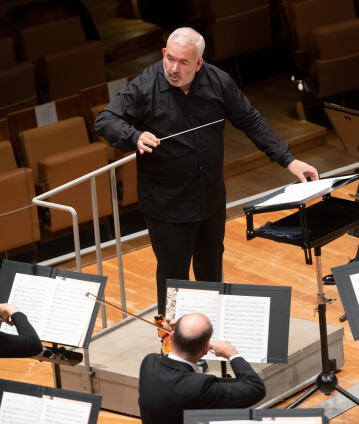Marc Minkowski conducts Haydn and Beethoven

God, rebel and bringer of fire – Prometheus is one of the most important figures in Greek mythology, a shining example of the Enlightenment and a symbol of its impossibility at the same time. Beethoven reworked Prometheus’s advocacy of mankind through his theft of fire into a heroic-allegorical ballet. It is preceded by a thematically related work, Joseph Haydn’s so-called “Fire Symphony” which is characterised by a passionate, dramatic tone.
Joseph Haydn’s appointment as kapellmeister to Prince Nikolaus I Esterházy meant both financial security and artistic isolation. During the summer months, the court was based around a hundred kilometres away from Vienna. “I was cut off from the world,” Haydn later recalled, but it was precisely this circumstance that offered him the opportunity to experiment with composition, because “no one around me could drive me mad or torment me, and so I had to become original.”
Haydn was lucky: the prince and the small courtly audience were delighted with his creative boldness. In Symphony No. 59, composed around 1768, Haydn plays with extreme dynamic contrasts and surprise effects. The symphony opens with an energetic outburst, an original initial spark – it is no surprise that one of Haydn’s contemporaries christened the work the “Fire” Symphony.
In the wake of the success of Haydn’s Creation, first performed in Vienna in 1798, Ludwig van Beethoven composed the thematically related ballet music for The Creatures of Prometheus. At its centre is Prometheus – literally “the one who thinks ahead” – who steals fire from the gods in order to use it to give mankind life and civilisation. The ancient myth could hardly have been more topical, as the rebellious Prometheus probably made everyone at the time think of Napoleon Bonaparte.
However, the narrative ballet choreographed by Salvatore Viganò – an innovative genre that rivalled the rather pantomime-like and static ballet of the old style in Vienna – did not focus on Prometheus but, in keeping with the title, on his creatures. Moulded from clay, the spark of the gods brings the first two humans to life. However, they can only learn sentience and reason through the arts, which ultimately makes Apollo, Bacchus, and the muses the real heroes. But anyone at the time who expected a cheerful dance of the muses set to a gentle musical backdrop knew little about the composer. As in his First Symphony, Beethoven began the overture in a self-confidently unconventional manner with a tension-filled chord seeking resolution. “Everything is too grand for a divertissement, which is what the ballet is supposed to be,” grumbled one critic after the premiere. But for Beethoven, humanistic education through (musical) art was undoubtedly a very serious matter – and not a mere muse.
© 2020 Berlin Phil Media GmbH
Related interviews
Artists
Our recommendations
- Simon Rattle conducts Beethoven’s “Pastoral” Symphony and Modernist concertos
- Mahler’s Third Symphony with Elīna Garanča and Lorenzo Viotti
- Neeme Järvi conducts Grieg’s “Peer Gynt” Suites
- Daniel Barenboim and Maria João Pires
- “The Golden Twenties”: Christian Thielemann conducts Hindemith, Strauss and Busoni
- Claudio Abbado conducts famous final movements at the 1999 New Year’s Eve Concert